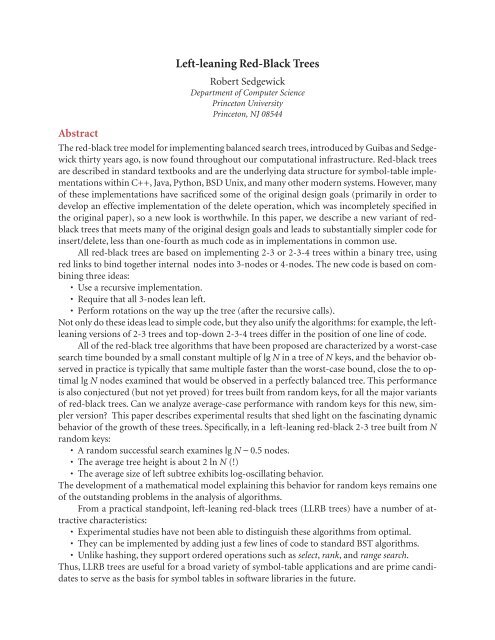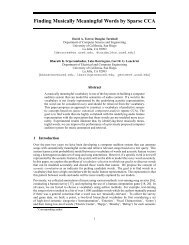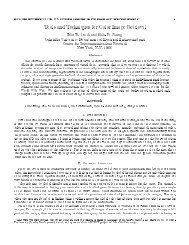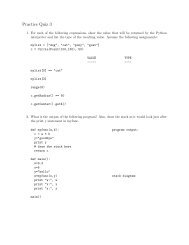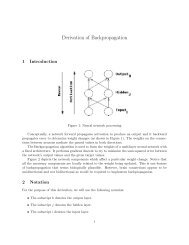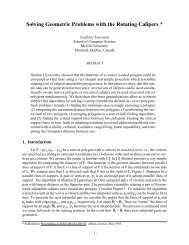Left-leaning Red-Black Trees - Princeton University
Left-leaning Red-Black Trees - Princeton University
Left-leaning Red-Black Trees - Princeton University
You also want an ePaper? Increase the reach of your titles
YUMPU automatically turns print PDFs into web optimized ePapers that Google loves.
<strong>Left</strong>-<strong>leaning</strong> <strong>Red</strong>-<strong>Black</strong> <strong>Trees</strong>Robert SedgewickDepartment of Computer Science<strong>Princeton</strong> <strong>University</strong><strong>Princeton</strong>, NJ 08544AbstractThe red-black tree model for implementing balanced search trees, introduced by Guibas and Sedgewickthirty years ago, is now found throughout our computational infrastructure. <strong>Red</strong>-black treesare described in standard textbooks and are the underlying data structure for symbol-table implementationswithin C++, Java, Python, BSD Unix, and many other modern systems. However, manyof these implementations have sacrificed some of the original design goals (primarily in order todevelop an effective implementation of the delete operation, which was incompletely specified inthe original paper), so a new look is worthwhile. In this paper, we describe a new variant of redblacktrees that meets many of the original design goals and leads to substantially simpler code forinsert/delete, less than one-fourth as much code as in implementations in common use.All red-black trees are based on implementing 2-3 or 2-3-4 trees within a binary tree, usingred links to bind together internal nodes into 3-nodes or 4-nodes. The new code is based on combiningthree ideas:• Use a recursive implementation.• Require that all 3-nodes lean left.• Perform rotations on the way up the tree (after the recursive calls).Not only do these ideas lead to simple code, but they also unify the algorithms: for example, the left<strong>leaning</strong>versions of 2-3 trees and top-down 2-3-4 trees differ in the position of one line of code.All of the red-black tree algorithms that have been proposed are characterized by a worst-casesearch time bounded by a small constant multiple of lg N in a tree of N keys, and the behavior observedin practice is typically that same multiple faster than the worst-case bound, close the to optimallg N nodes examined that would be observed in a perfectly balanced tree. This performanceis also conjectured (but not yet proved) for trees built from random keys, for all the major variantsof red-black trees. Can we analyze average-case performance with random keys for this new, simplerversion? This paper describes experimental results that shed light on the fascinating dynamicbehavior of the growth of these trees. Specifically, in a left-<strong>leaning</strong> red-black 2-3 tree built from Nrandom keys:• A random successful search examines lg N – 0.5 nodes.• The average tree height is about 2 ln N (!)• The average size of left subtree exhibits log-oscillating behavior.The development of a mathematical model explaining this behavior for random keys remains oneof the outstanding problems in the analysis of algorithms.From a practical standpoint, left-<strong>leaning</strong> red-black trees (LLRB trees) have a number of attractivecharacteristics:• Experimental studies have not been able to distinguish these algorithms from optimal.• They can be implemented by adding just a few lines of code to standard BST algorithms.• Unlike hashing, they support ordered operations such as select, rank, and range search.Thus, LLRB trees are useful for a broad variety of symbol-table applications and are prime candidatesto serve as the basis for symbol tables in software libraries in the future.
IntroductionWe focus in this paper on the goal of providing efficient implementations of the following operationson in a symbol table containing generic keys and associated values.• Search for the value associated with a given key.• Insert a key-value pair into the symbol table.• Delete the key-value pair with a given key from the symbol table.When an insert operation involves a key that is already in the table, we associate that key with thenew value, as specified. Thus we do not have duplicate keys in the table and are implementingthe associative array abstraction. We further assume that keys are comparable : we have available acompare operation that can determine whether one given key is less than, equal to, or greater thananother given key, so that we preserve the potential to implement the ordered associative array abstraction,where we can support rank, select, range search, and similar operations that are of criticalimportance in many applications.Developing data structures and efficient algorithms for these operations is an old and wellstudiedproblem. The starting point for this paper is the balanced tree data structures that weredeveloped in the 1960s and 1970s, which provide a guaranteed worst-case running time that is proportionalto log N for both operations. These algorithms are based on modifying the elementarybinary search tree (BST) data structure to guarantee that the length of every path to an externalnode is proportional to log N. Examples of such algorithms are 2-3 trees, 2-3-4 trees, AVL trees,and B trees. This paper is largely self-contained for people familiar with balanced-tree algorithms;others can find basic definitions and examples in a standard textbook such as [6], [9], or [13].In [7], Guibas and Sedgewick showed that all of thesealgorithms can be implemented with red-black trees, whereeach link in a BST is assigned a color (red or black) thatcan be used to control the balance, and that this frameworkcan simplify the implementation of the various algorithms.In particular, the paper describes a way to maintaina correspondence between red-black trees and 2-3-4 trees,by interpreting red links as internal links in 3-nodes and4-nodes. Since red links can lean either way in 3-nodes(and, for some implementations in 4-nodes), the correspondenceis not necessarily 1-1. For clarity in our code,we use a boolean variable (a single bit) to encode the colorof a link in the node it points to, though Brown [5] has pointed out that we can mark nodes as redby switching their pointers, so that we can implement red-black trees without any extra space.One of the most important feature of red-black trees is that they add no overhead for search,the most commonly used operation. Accordingly, red-black trees are the underlying data structurefor symbol-table implementations within C++, Java, Python, BSD Unix, and many other systems.Why revisit such a successful data structure? The actual code found in many implementationsis difficult to maintain and to reuse in new systems because it is lengthy, running 100-200 lines ofcode in typical implementations. Full implementations are rarely found in textbooks, with numerous“symmetric” cases left for the student to implement. In this paper, we present an approach thatcan dramatically reduce the amount of code required. To prove the point, we present a full Javaimplementation, comprising three short utility methods, adding 3 lines of code to standard BSTcode for insert, a 5-line method for delete the maximum, and 30 additional lines of code for delete.ACA CEE JHHJLLMMPRPS X Z<strong>Red</strong>-black representation of a 2-3-4 treeRSXZ
Rotations and color flipsOne way to view red-black BST algorithms is as maintaining the following invariant propertiesunder insertion and deletion:• No path from the root to the bottom contains two consecutive red links.hlessthan aNode rotate<strong>Left</strong>(Node h){x = h.right;h.right = x.left;x.left = h;x.color = h.color;h.color = RED;return x;}hlessthan aaacould be right or left,red or blackbetweena and bbetweena and b<strong>Left</strong> rotate (right link of h)bbxgreaterthan bxgreaterthan b• The number of black links on every such path is the same.These invariants imply that the length of every path in a red-black tree with N nodes is no longerthan 2 lg N . This worst case is realized, for example, in a tree whose nodes are all black except forthose along a single path of alternatingred and black nodes.The basic operations that balanced-treealgorithms use to maintainbalance under insertion anddeletion are known as rotations. Inthe context of red-black trees, theseoperations are easily understoodas the transformations needed totransform a 3-node whose red linkleans to the left to a 3-node whosered link leans to the right and viceversa.The Java code for these operations(for a Node type that wewill consider late that contains a leftlink, a right link, and a color fieldthat can be set to the value RED torepresent the color of the incominglink) is given to the left and to theright on this page. Rotations obviouslypreserve the two invariantsstated above.In red-black trees, we also usea simple operation known as a colorflip (shown at the bottom of thisNode rotateRight(Node h){x = h.left;h.left= x.right;x.right= h;x.color = h.color;h.color = RED;return x;}Right rotate (left link of h)page). In terms of 2-3-4 trees, a color flip is the essential operation: it corresponds to splitting a4-node and passing the middle node up to the parent. A color flip obviously does not change thenumber of black links on any path from the root to the bottom, but it may introduce two consecutivered links higher in the tree, which must be corrected.<strong>Red</strong>-black BST algorithms differ on whether and when they do rotations and color flips, inorder to maintain the global invariants stated at the top of this page.xlessthan axlessthan aaabetweena and bbetweena and bbbhgreaterthan bhgreaterthan bhcould be leftor right linkvoid flipColors(Node h){h.color = !h.color;h.left.color = !h.left.color;h.right.color = !h.right.color;}Flipping colors to split a 4-nodeblack links splitto 2-nodesred linkattachesmiddle nodeto parent
<strong>Left</strong>-<strong>leaning</strong> red-black treesOur starting point is the Java implementation of standard BSTs shown in the gray code on the nextpage. Java aficionados will see that the code uses generics to support, in a type-safe manner, arbitrarytypes for client keys and values. Otherwise, the code is standard and easily translated to otherlanguages or adapted to specific applications where generic types may not be needed.In the present context, an important feature of the implementation is that the implementationof insert() is recursive : each recursive call takes a link as argument and returns a link, which isused to reset the field from which the link was taken. For standard BSTs, the argument and returnvalue are the same except at the bottom of the tree, where this code serves to insert the new node.For red-black trees, this recursive implementation helps simplify the code, as we will see. We couldalso use a recursive implementation for search() but we do not do so because this operation fallswithin the inner loop in typical applications.The basis of algorithms for implementing red-black trees is to add rotate and color flip operationsto this code, in order to maintain the invariants that dictate balance in the tree. Most publishedimplementations involve code laden with cases that are nearly identical for right and left. Inthe code in this paper, we show that the number of cases can be substantially reduced by:• requiring that 3-nodes always lean to the left (and that 4-nodes are balanced)• doing rotations after the recursive calls, on the way up the tree.The lean-to-the-left requirement gives a 1-1 correspondence between red-black and 2-3-4 trees andreduces the number of cases to consider. The rotate-on-the-way up strategy simplifies the code (andour understanding of it) by combining various cases in a natural way. Neither idea is new (the firstwas used by Andersson [2] and the second is used in [9]) but in combination they surprisingly effectivein reducing the amount of code required for several versions of the data structure. The codein black on the next page derives two classic algorithms by adding 3 lines of code to insert().Top-down 2-3-4 trees To insert a new node, we flip colorsto split any 4-node encountered on the way downthe tree and do rotations to balance 4-nodes (eliminateoccurrences of consecutive red links on the way up thetree). This approach is natural because splitting 4-nodesto ensure that the search does not terminate on a 4-nodemeans that a new node can be added by attaching it witha red link, and balancing a 4-node amounts to handlingthe three possible ways a red link could be attached to a3-node, as shown in the diagram at right. If the red linkthat is passed up happens to lean to the right in a 3-node,we correct that condition when we encounter it.rightrotateleftrotateflipcolorsPassing a red link up in a LLRB tree2-3 trees Remarkably, moving the color flip to the end inthe top-down 2-3-4 tree implementation just described yields an implementation for 2-3 trees. Wesplit any 4-node that is created by doing a color flip, passing a red link up the tree, and dealing withthe effects of doing so in precisely the same way as we move up the tree.These ideas are also effective for simplifying other variations of red-black trees that have beenstudied, which we cannot consider in this short abstract for lack of space. These include handlingequal keys, completing the insertion in a single top-down pass, and completing the insertion withat most one rotation in 2-3-4 trees.
public class LLRB{private static final boolean RED = true;private static final boolean BLACK = false;private Node root;private class Node{private Key key;private Value val;private Node left, right;private boolean color;Node(Key key, Value val){this.key = key;this.val = val;this.color = RED;}}represent color with a 1-bit fieldnew nodes are always redpublic Value search(Key key){Node x = root;while (x != null){int cmp = key.compareTo(x.key);if (cmp == 0) return x.val;else if (cmp < 0) x = x.left;else if (cmp > 0) x = x.right;}return null;}public void insert(Key key, Value value){root = insert(root, key, value);root.color = BLACK;}private Node insert(Node h, Key key, Value value){if (h == null) return new Node(key, value);if (is<strong>Red</strong>(h.left) && is<strong>Red</strong>(h.right)) colorFlip(h);move this line int cmp = key.compareTo(h.key);if (cmp == 0) h.val = value;to the endelse if (cmp < 0) h.left = insert(h.left, key, value);to getelseh.right = insert(h.right, key, value);2-3 treesif (is<strong>Red</strong>(h.right) && !is<strong>Red</strong>(h.left)) h = rotate<strong>Left</strong>(h);if (is<strong>Red</strong>(h.left) && is<strong>Red</strong>(h.left.left)) h = rotateRight(h);}}return h;Java code to implement LLRB trees (standard BST code in gray)
DeletionEfficient implementation of the delete operation is a challenge in many symbol-table implementations,and red-black trees are no exception. Industrial-strength implementations run to over 100lines of code, and text books generally describe the operation in terms of detailed case studies,eschewing full implementations. Guibas and Sedgewick presented a delete implementation in [7],but it is not fully specified and depends on a call-by-reference approach not commonly found inmodern code. The most popular method in common use is based on a parent pointers (see [6]),which adds substantial overhead and does not reduce the number of cases to be handled.The code on the next page is a full implementation of delete() for LLRB 2-3 trees. It is basedon the reverse of the approach used for insert in top-down 2-3-4 trees: we perform rotations andcolor flips on the way down the search path to ensure that the search does not end on a 2-node, sothat we can just delete the node at the bottom. We use the method fixUp() to share the code for thecolor flip and rotations following therecursive calls in the insert() code.With fixUp(), we can leave right<strong>leaning</strong>red links and unbalanced4-nodes along the search path, securethat these conditions will be fixed onthe way up the tree. (The approach isalso effective 2-3-4 trees, but requiresan extra rotation when the right nodeoff the search path is a 4-node.)As a warmup, consider the delete-the-minimumoperation, wherethe goal is to delete the bottom nodeon the left spine while maintainingbalance. To do so, we maintain the invariantthat the current node or its leftchild is red. We can do so by movingto the left unless the current node ispublic void deleteMin(){root = deleteMin(root);root.color = BLACK;}private Node deleteMin(Node h){if (h.left == null) return null;}if (!is<strong>Red</strong>(h.left) && !is<strong>Red</strong>(h.left.left))h = move<strong>Red</strong><strong>Left</strong>(h);h.left = deleteMin(h.left);return fixUp(h);Delete-the-minimum code for LLRB 2-3 treesred and its left child and left grandchild are both black. In that case, we can do a color flip, whichrestores the invariant but may introduce successive reds on the right. In that case, we can correctthe condition with two rotations and a color flip. These operations are implemented in the move<strong>Red</strong><strong>Left</strong>()method on the next page. With move<strong>Red</strong><strong>Left</strong>(), the recursive implementation of deleteMin()above is straightforward.For general deletion, we also need move<strong>Red</strong>Right(), which is similar, but simpler, and we needto rotate left-<strong>leaning</strong> red links to the right on the search path to maintain the invariant. If the nodeto be deleted is an internal node, we replace its key and value fields with those in the minimumnode in its right subtree and then delete the minimum in the right subtree (or we could rearrangepointers to use the node instead of copying fields). The full implementation of delete() that derviesfrom this discussion is given on the facing page. It uses one-third to one-quarter the amountof code found in typical implementations. It has been demonstrated before [2, 11, 13] that maintaininga field in each node containing its height can lead to code for delete that is similarly concise,but that extra space is a high price to pay in a practical implementation. With LLRB trees, we canarrange for concise code having a logarithmic performance guarantee and using no extra space.
private Node move<strong>Red</strong><strong>Left</strong>(Node h){colorFlip(h);if (is<strong>Red</strong>(h.right.left)){h.right = rotateRight(h.right);h = rotate<strong>Left</strong>(h);colorFlip(h);}return h;}move<strong>Red</strong><strong>Left</strong>(h) example: hcolorflip(h)aabbccprivate Node move<strong>Red</strong>Right(Node h){colorFlip(h);if (is<strong>Red</strong>(h.left.left)){h = rotateRight(h);colorFlip(h);}return h;}h.right = rotateRight(h.right)h = rotate<strong>Left</strong>(h)colorflip(h)aaabbbcccpublic void delete(Key key){root = delete(root, key);root.color = BLACK;}private Node delete(Node h, Key key){if (key.compareTo(h.key) < 0){if (!is<strong>Red</strong>(h.left) && !is<strong>Red</strong>(h.left.left))h = move<strong>Red</strong><strong>Left</strong>(h);h.left = delete(h.left, key);}else{if (is<strong>Red</strong>(h.left))h = rotateRight(h);if (key.compareTo(h.key) == 0 && (h.right == null))return null;if (!is<strong>Red</strong>(h.right) && !is<strong>Red</strong>(h.right.left))h = move<strong>Red</strong>Right(h);if (key.compareTo(h.key) == 0){h.val = get(h.right, min(h.right).key);h.key = min(h.right).key;h.right = deleteMin(h.right);}else h.right = delete(h.right, key);}}return fixUp(h);Delete code for LLRB 2-3 trees
Properties of LLRB trees built from random keysBy design, the worst-case cost of a search in an LLRB tree with N nodes is 2 lg N. In practical applications,however, the cost of a typical search is half that value, not perceptibly different fromthe cost of a search in a perfectly balanced tree. Since searches are far more common than insertsin typical symbol-table applications, the usual first step in studying a symbol-table algorithm is toassume that a table is built from random keys (precisely, a random permutation of distinct keys)and then study the cost of searchers. For standard BSTs and other methods, mathematical modelsbased on this assumption have been developed and validated with experimental results and practicalexperience. The development of a corresponding mathematical model for balanced trees is oneof the outstanding problems in the analysis of algorithms.In this paper, we present experimental results that may help guide the development of such amodel, using a modified form of a plot format suggested by Tufte [12]. Specifically, we use• a gray dot to depict the result of each experiment• a red dot to depict the average value of the experiments for each tree size• black line segments to depict the standard deviation of the experiments for each tree size, oflength and spaced above and below the red dotsWhile sometimes difficult to distinguish individually, the gray dots help illustrate the extent andthe dispersion of the experimental results. The plots at right each represent the results of 50,000experiments, each involving building a2-3 tree from a random permutationof distinct keys.average successful search cost ( ipl / N )18comparesAverage path length. What is the costlg N − .5of a typical search? That is the questionof most interest in practice. In typical10large-scale applications, most searchestree size Nare successful and bias towards specifickeys is relatively insignificant, so100050000the measuring the average length to anode in a tree constructed from randomkeys is a reasonable estimate. As2421.7shown in our first plot, this measure isextremely close to the optimal value lg1000 experiments per sizeN − .5 that would be found in a fullybalanced tree. The plots for top-down2 ln N2-3-4 trees and other types of redblacktrees are indistinguishable fromtree size N10100050000this one.Height. What is the expected worstcasesearch cost? This question is primarilyof academic interest, but may shed some light on the structure of the trees. Though thedispersion is much higher than the average, our second plot shows that the height is close to 2 lnN, the same value as the average cost of a search in a BST (!). However, this precise value is pureconjecture: for example, experiments for standard BSTs would suggest the average height 3 lg N ,but the actual value of the coefficient is known to be slightly less than 3.worst-case search cost ( tree height )heightExperimental results for LLRB trees built from random keys18.51000 experiments per size
Distribution. The first step to developing a mathematical model that explains these results is tounderstand the distribution of the probability p kthat the root is of rank k, when a LLRB (2-3)tree is built from random keys. We know this probability to be 0 for small k and for large k, and4tree size N50010000 experiments per sizek/NLLRB tree root rank distribution10.5p k (offset)0we expect it to be high when k isnear N/2. The figure at left showsthe result of computing the distributionexactly for small N andestimating its shape for intermediatevalues of N. Following theformat introduced in [10], thecurves are normalized on the xaxis and slightly separated onthe y axis, so that convergence toa distribution can be identified.The irregularities in the curvesare primarily (but not completely)due to expected variations inthe experimental results. (Thesecurves are the result of building10000 trees for each size, and aresmoother than the curves basedAverage root rank in LLRB treeson a smaller number of experiments). Ideally, we would like to see convergence at the bottom tosome distribution (whose properties we can analyze) for large N. Though it suggests the possibilityof eventual convergence to a distribution that can be suitable approximated, this figure also exhibitsan oscillation that may complicate such analysis. At right is shown a Tufte plot of the average forthis distribution for a large number of experiments. This figure clearly illustrates a log-oscillatorybehavior that is often found in the analysis of algorithms, and also shows that the dispersion is significantand does not seem to be decreasing.<strong>Red</strong> path length. How many red nodes are on the search path, on the average? This question wouldseem to be the key to understanding LLRB trees. The figure below shows that this varies (even10tree size N500.3200 experiments per sizerank / N.7Tree ATree Baverage number of nodes per path after each insertionred nodesredsblacks2 6 20 44 902 6 19 36Path lengths in two random LLRB trees
4reds110tree sizeAverage number of reds per path in random LLRB treesthough the total is relatively smooth. Close examination reveals that the average number of reds perpath increases slowly, then drops each time the root splits. One important challenge is to characterizethe root split events. The remarkablefigure at right shows that variability inthe time of root splits creates a significantchallenge in developing a detailedcharacterization of the average numberof red nodes per path. It is a modifiedTufte plot showing that this quantity oscillatesbetween periods of low and highvariance and increases very slowly, if atall. This behavior is the result of averagingthe sawtooth plots with differentroot split times like the ones at the bottomof the previous page. It is quite remarkable that the quantity of primary practical interest (theaverage path length) should be so stable (as shown in our first plot and in the sum of the blackand red path lengths in the plot at the bottom of the previous), but the underlying process shouldexhibit such wildly oscillatory behavior.AcknowledgementThe author wishes to thank Kevin Wayne for many productive discussions and for rekindling interestin this topic by encouraging work on the delete implementation.References1. G. M. Adelson-Velskii and E. M. Landis, An algorithm for the organization of information, Soviet Math.Doklady 3 (1962), 1259 –1263.2. A. Andersson, Balanced search trees made simple, Proceedings of the 3rd Workshop on Algorithmsand Data Structures (1993), 290 –306.3. R. Baeza-Yates, Fringe analysis revisited, ACM Computing Surveys 27 (1995), 109 –119.4. R. Bayer, Symmetric binary B-<strong>Trees</strong>: data structure and maintenance algorithms, Acta Informatica 1(1972), 290 –306.5. M. Brown, Some observations on 2-3 trees, Information Processing Letters 9 (1979), 57 –59.6. T. H. Cormen, C. E. Leiserson, R. L. Rivest and C. Stein, Introduction to Algorithms, MIT Press.7. L. Guibas and R. Sedgewick, A dichromatic framework for balanced trees, Proceedings of the 19th AnnualConference on Foundations of Computer Science, Ann Arbor, MI (1978). (Also in A Decade ofResearch — Xerox Palo Alto Research Center 1970–1980, ed. G. Laverdel and E. R. Barker).8. D. E. Knuth, The Art of Computer Programming, Vol. 3, Sorting and Searching, Addison–Wesley.9. R. Sedgewick, Algorithms in Java, Parts 1–4: Fundamentals, Data Structures, Sorting, and Searching,Addison–Wesley.10. R. Sedgewick and P. Flajolet, Introduction to the Analysis of Algorithms, Addison–Wesley, 1996.11. R. Seidel, personal communication.12. E. Tufte, Envisioning Information, Graphics Press, Chesire, CT, 1990.13. M. Weiss, Data Structures and Problem Solving using Java, Addison-Wesley, 2002.14. A. Yao, On random 2-3 trees, Acta Informatica 9 (1978), 159 –170.500


